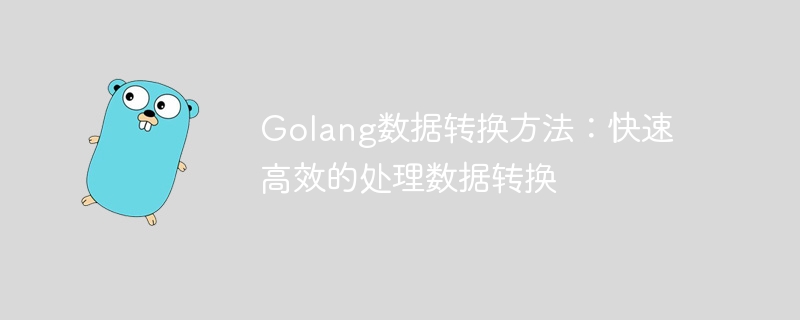Home >Backend Development >Golang >Efficient and fast Golang data conversion techniques
Efficient and fast Golang data conversion techniques
- WBOYWBOYWBOYWBOYWBOYWBOYWBOYWBOYWBOYWBOYWBOYWBOYWBOriginal
- 2024-02-20 10:30:24812browse

In software development, data conversion is a common task, especially when dealing with complex data structures or different data types. In the Go language, also known as Golang, there are many fast and efficient ways to handle data conversion, allowing developers to easily convert between different data types.
1. Use built-in type conversion
The built-in type conversion of Go language is one of the most basic data conversion methods. Data conversion can be done quickly by directly converting data from one type to another. Here is a simple example to convert an integer to a floating point number:
package main
import "fmt"
func main() {
num1 := 10
num2 := float64(num1)
fmt.Println(num2)
} In this example, we convert the integer num1 to a floating point number num2, and Output results.
2. Use the strconv package for string conversion
In the Go language, you can use the strconv package to convert between strings and other data types. This package provides some functions to handle conversions between different types, such as converting integers to strings, converting strings to integers, etc.
Here is an example to convert an integer to a string:
package main
import (
"fmt"
"strconv"
)
func main() {
num := 10
str := strconv.Itoa(num)
fmt.Println(str)
}In this example, we use the strconv.Itoa function to convert an integer numConvert to string str and output the result.
3. Use the json package to convert structures and JSON data
In Go language, you can use the json package to convert structures and JSON data Convert. This is particularly useful when processing web requests and responses, because many times the structure needs to be converted into JSON data and returned to the client.
The following is an example to convert a structure into JSON data:
package main
import (
"encoding/json"
"fmt"
)
type Person struct {
Name string `json:"name"`
Age int `json:"age"`
}
func main() {
person := Person{Name: "Alice", Age: 25}
data, _ := json.Marshal(person)
fmt.Println(string(data))
}In this example, we define a Person structure and then use The json.Marshal function converts the structure person into JSON data and outputs the result.
4. Use map for data conversion
In the Go language, map is a very flexible data structure that can be used for data conversion. By storing data in a map, you can easily convert between different data types.
The following is an example of saving multiple key-value pairs in a map for data conversion:
package main
import "fmt"
func main() {
demoMap := make(map[string]interface{})
demoMap["name"] = "Bob"
demoMap["age"] = 30
name := demoMap["name"].(string)
age := demoMap["age"].(int)
fmt.Println(name, age)
}In this example, we create a map stores key-value pairs named name and age. When needed, data is taken from map and converted to the corresponding data type. .
Summary:
In the Go language, there are many fast and efficient methods to handle data conversion, and developers can choose the appropriate conversion method according to the specific situation. Whether it is simple type conversion, string conversion, structure conversion or data storage conversion, the Go language provides a wealth of functions and libraries to help developers complete data conversion tasks. By flexibly using these methods, developers can easily handle various data conversion needs and improve program efficiency and maintainability.
The above is the detailed content of Efficient and fast Golang data conversion techniques. For more information, please follow other related articles on the PHP Chinese website!
Related articles
See more- Introduction to the method of converting file data into a two-dimensional list using python
- How to convert data to integer in javascript
- Let's talk about the simple and efficient Excel pivot table
- High-concurrency instance sharing: Swoole efficiently implements business through aggregation of requests
- How to use thinkorm to quickly convert and connect database data

